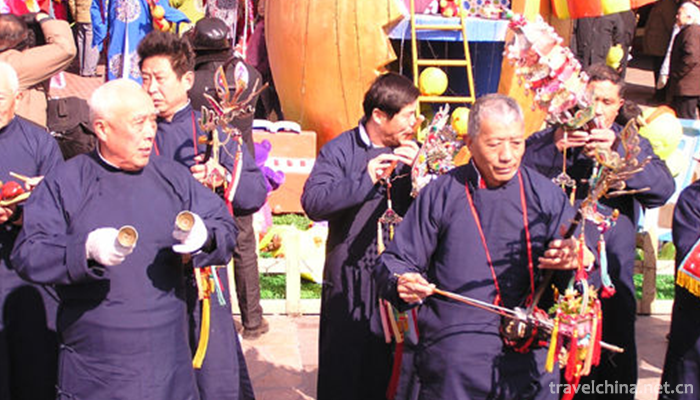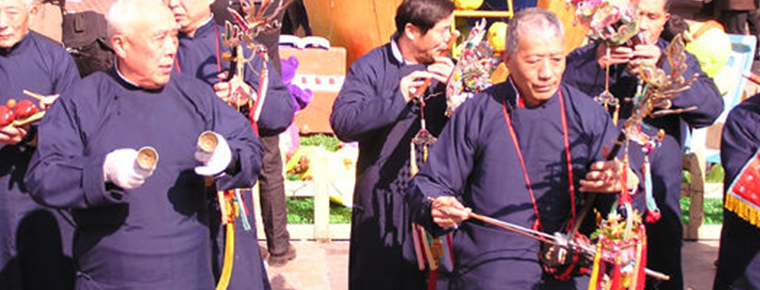Jiangnan bamboo
Jiangnan bamboo
Chinese traditional instrumental music, silk and bamboo, is popular in southern Jiangsu and Zhejiang. After the Revolution of 1911, great progress was made in Shanghai, and organizations such as Juntian Collection, Qingping Collection, Elegant Songs Collection and National Music Research Society were established successively. Frequently played are "Happy Song", "Yunqing", "Street", "Four Harmonies", "Three Six", "Slow Three Six", "Zhonghua Six Board", "Slow Six Board", "Eight Famous Melodies". In addition, music such as Lao Liu Ban, Quick Six Banks, Neon Clothes, Liu Qingniang, Pigeon Flying, Alpine, Running Water and Laminated Building are also popular. The Orchestra of Silk Bamboo in the south of the Yangtze River is usually composed of 7 to 8 people, with a small number of 3 to 5 people.
Silk bamboo in the south of the Yangtze River is also one of the national intangible cultural heritage.
In December 2018, the General Office of the Ministry of Education announced that Suzhou University is an excellent traditional cultural heritage base of silk and bamboo in the south of the Yangtze River.
brief introduction
The music structure of Silk Bamboo in the south of the Yangtze River is mainly composed of two types: plate-style change and qu-pai conjunction, and the plate-style change technique is the most characteristic. It tends to use a musical card as its mother song and develop into several independent pieces by slowing down the adding of flowers or accelerating the subtraction of words. For example, the folk instrumental music "Lao Liu Ban" evolved into five pieces of music, commonly known as "five generations together". It evolved from fast to slow, from simple to complex. The first song "Old Six Boards", the flowing board, the melody is simple; the second song "Fast Six Boards", the flowing board, the melody is vivid and lively; the third song "Middle Six Boards", one board and one eye, the melody is light and smooth; the fourth song "Middle Six Boards", one board and three eyes, the melody is fluent and the speed is moderate, the most famous in the five songs; the fifth song "Slow Six Boards", one board and seven eyes, the melody is elegant and slow. These five pieces can be played independently or in the opposite direction according to the playing procedure. For example, starting from the fifth song Slow Six Boards, they can be played from slow to fast, from complex to simple in sequence.
The silk and bamboo melodies in the south of the Yangtze River are beautiful in lyricism and fresh and fluent in style. The flute performance pays attention to the use of breath. The tenor is melodious and clear, the bass is implicit and tactful, and the timbre is mellow and mellow. The melody is often embellished with such techniques as pronunciation, relief, donation, tremolo and so on. Erhu bow method is full and soft, and its strength changes delicately. Left hand is used to penetrate, tape, left side tone and hook tone. Especially with various slippery tone techniques, it constitutes the delicate, delicate and bright personality of Jiangnan silk and bamboo. Instrumental music is popular in southern Jiangsu, Shanghai and Western Zhejiang. The band is mainly composed of silk strings and bamboo wind instruments, so it is called silk and bamboo music. It was popular among the people at least before 1860 in the Qing Dynasty.
Silk and bamboo music
Jiangnan silk bamboo is a very popular instrumental ensemble form of Qiandeng, whose founder Tao Lan is Qiandeng Ren. Every wedding and funeral festival, Qiandeng people should use this to increase the festive atmosphere, or to mourn their loved ones. The silk and bamboo instruments in the south of the Yangtze River are basically composed of silk strings and bamboo wind instruments, including erhu, pipa, yangqin, three strings, flute, Sheng and xiao, and some percussion instruments such as drums and boards. There are two or three people in the compilation, and seven or eight in the compilation. In ensemble, each instrument is full of distinct individuality and harmony with each other. Variations of flower are commonly used. The style is elegant and gorgeous, the melody is smooth and euphemistic. It reflects the industrious, simple, meticulous and implicit characteristics of Jiangnan people. The Silk Bamboo Team of Qiandeng is very common. There are many silk and bamboo classes among the people, serving the wedding and funeral festivals. Qinfeng Silk and Bamboo Team is organized in the town. It has rehearsal rooms and musical instrument showrooms. Twelve members mainly come from enterprises and institutions such as Wenguang Station and schools. They perform daily in the Silk and Bamboo Hall for tourists.
The silk and bamboo Orchestra in the south of the Yangtze River is named because it mainly consists of Erhu, Yangqin, Pipa, Sanxian, Qinqin, flute, Xiao and other silk and bamboo instruments. Silk and bamboo music is very popular in cities and countryside in these areas, but its style is totally different. The style of city silk and bamboo music is elegant and gorgeous, with more flowers, and it is widely spread; while gongs and drums are commonly used in rural areas, with warm atmosphere and simple style.
Musical characteristics
The greatest characteristic of Jiangnan silk bamboo is its fine playing style. When playing, each part of the instrument is full of individuality and harmony, and the polyphonic texture of supporting tone has its own characteristics. Music mostly comes from folk music of weddings, funerals, festivals and temple fairs in China, and some are classical music cards that have been circulating in Chinese people for a long time.
Valuable legacy
The emergence and continuation of silk and bamboo music in the south of the Yangtze River play an important role in the study of the history of Chinese national music and the development of opera, folk culture and mass culture. Silk bamboo in the south of the Yangtze River is one of the outstanding representatives of the water culture in the south of the Yangtze River.
By the 1960s and 1970s, the traditional Jiangnan Silk and Bamboo Band Society had been dissolved by itself. Up to now, old artists over 70 years old have passed away one after another, and there are few successors. In addition, the traditional repertoire of silk and bamboo in the south of the Yangtze River is becoming more and more endangered.
The state attaches great importance to the protection of intangible cultural heritage. On May 20, 2006, Jiangnan silk bamboo jointly declared by Taicang City, Jiangsu Province and Shanghai City was listed in the first batch of national intangible cultural heritage list with the approval of the State Council.


-
2.Xiangsha Bay Scenic Spot in Dalat Banner Ordos
Xiangsha Bay was opened as a tourist attraction in January 1984, listed as a national line scenic spot by the National Tourism Administration in 1991
Time 2018-11-29 -
3.Yunlong Lake
Located in the southwest of Xuzhou City, Jiangsu Province, Yunlong Lake is the main scenic spot of Yunlong Lake Scenic Area in Xuzhou, formerly known as "Stone Dog Lake"
Time 2018-12-06 -
4.Huaqing Pool Scenic Area
Tang Huaqing Palace is another palace for feudal emperors in Tang Dynasty. Later also known as "Huaqing Pool", located in Lintong District, Xi'an City, Shaanxi Province.
Time 2018-12-12 -
5.Huangpi Mulan Cultural Ecotourism Area
Wuhan Huangpi Mulan Cultural Eco-tourism Area is located in Huangpi District, Wuhan City, Hubei Province, including Mulan Mountain, Mulan Tianchi, Mulan Grassland
Time 2018-12-12 -
6.rime island
Wuluo Island, an island on the Songhua River, is located in the Manchu town of Ura Street, Longtan District, Jilin Province. The villages of Hantun and Zeng Tongtun in Manchu Town of Ura Street are th
Time 2019-02-25 -
7.Dang Tu folk songs
Dangtu Folk Song is one of the national intangible cultural heritages of the local traditional music in Ma'anshan City, Anhui Province.
Time 2019-04-25 -
8.Larenbu and Jimenso
With vivid images, deep and solemn language and singing form, Larenbu and Jimenso described the love tragedy of the poor Larenbu and the pastor's sister Jimensoe, who developed from employer relations
Time 2019-05-10 -
9.Qu Opera
Opera is one of the traditional operas mainly spread in Henan Province. It was also called "Gaotai Opera" or "Quzi Opera" in the old days. Quju is popular in Henan Province and its
Time 2019-06-11 -
10.Tujia Wedding Song
The Tujia people living in the border areas of Hunan, Hubei, Chongqing and Guizhou are an ancient civilized nation with a long history and traditional customs, and retain strong national characteristi
Time 2019-06-23 -
11.String Dance
String dance is popular in Sichuan, Yunnan and other Tibetan areas and in Changdu, Tibet. String dance is an indispensable self-musical dance in Tibetan people's life. During festivals, weddings and g
Time 2019-07-03 -
12.Meishan science and technology
In 2019, 80 science and technology projects above the municipal level will be organized and implemented, and 27.73 million yuan of free science and technology project funds will be put in place. In the whole year, 433 patents were applied and 94 patents were
Time 2020-12-18